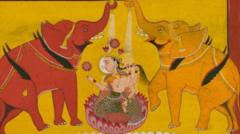Is This the Best Horror Film Coming to Amazon Prime Next Week?

Exploring the Impact of Robert Eggers' Nosferatu: A Modern Classic in Horror Cinema
Robert Eggers' latest adaptation of Nosferatu has taken the horror film community by storm, garnering a commendable critics' score of 84% on Rotten Tomatoes, contrasted with an audience score of 73%. This stark difference highlights the divide between critical acclaim and viewer reception, a topic that often sparks robust discussions in film circles. In this article, we will delve deep into the themes, performances, and cinematic techniques that make this film a must-see, while also exploring the personal experiences of its cast and crew during production.
The Legacy of Nosferatu
Nosferatu, originally released in 1922, is a silent film that has become synonymous with the horror genre. Directed by F.W. Murnau, it was the first-ever screen adaptation of Bram Stoker's "Dracula." The iconic imagery and themes of obsession, fear, and the unknown have paved the way for countless adaptations and inspired generations of filmmakers. Eggers’ reinterpretation seeks to honor this legacy while infusing new life into the story.
Critical Reception: A Mixed Bag
As noted, the critical reception of Nosferatu is notably higher than that of the audience score. Critics have praised Eggers for maintaining the film's Gothic atmosphere, powerful performances, and innovative storytelling. Jonathan M, for instance, remarked on the "beautifully dark atmosphere" and the film's ability to stay true to the spirit of the original while introducing fresh twists. This balance of homage and innovation is crucial in horror films, where audiences often crave both familiarity and novelty.
- Atmospheric Elements: Critics have highlighted the film's stunning visuals and sound design, which contribute significantly to its eerie and unsettling atmosphere.
- Performance Quality: The cast has received acclaim for their ability to convey deep emotional and psychological states, adding layers to their characters.
- Innovative Storytelling: Eggers has been commended for his unique take on the classic narrative, making it relevant to contemporary audiences.
However, not all viewers share the same enthusiasm. Audience members like Tyler F expressed a visceral connection to the film, stating, "You cannot unsee this movie." This highlights the film's ability to leave a lasting impression, even if not everyone agrees on its merits.
Character Development and Performance
The heart of any film lies in its characters, and Eggers' Nosferatu is no exception. The film’s portrayal of Count Orlok, played by a talented actor whose performance has been described as hauntingly compelling, brings a new dimension to the classic vampire archetype. This reimagining focuses on psychological horror rather than traditional gore and jump scares, appealing to audiences who prefer depth over shock value. Ronald M noted the film's emphasis on atmospheric creepiness, which allows for a more profound exploration of fear.
The Journey of Count Orlok
Count Orlok's gradual introduction is a key aspect of the film's success. Unlike many modern horror films that rely on immediate shock tactics, Eggers opts for a slow build-up of tension. Jacob M described this gradual unveiling as "captivating," suggesting that it allows audiences to become invested in the story and its characters.
Supporting Characters and Their Impact
The supporting characters also play a vital role in enhancing the narrative. Each character serves to deepen the thematic exploration of obsession, fear, and the supernatural. The relationships between these characters are complex and often fraught with tension, adding layers to an already rich narrative tapestry.
The Cinematic Techniques: Crafting a Horror Masterpiece
Eggers is known for his meticulous attention to detail and innovative filmmaking techniques, both of which shine in this adaptation of Nosferatu. The film employs a mix of practical effects, sound design, and cinematography to create a uniquely immersive experience.
Visual Aesthetics
The visual style of Nosferatu pays homage to its silent film roots while incorporating modern techniques. The use of shadow and light is particularly striking, creating an unsettling atmosphere that enhances the film's themes. The make-up effects on Count Orlok have been described as "excellent," contributing to the character's nightmarish presence.
Sound Design: Amplifying the Horror
Sound design is often an underappreciated aspect of horror films, yet Eggers’ use of sound elevates the viewing experience. The film features visceral sound effects that make the bloodsucking moments feel raw and intense. This attention to auditory detail adds to the film's overall sense of dread and immersion.
The Filming Experience: Behind the Scenes
While the film's narrative is dark and haunting, the filming experience was not without its own share of thrills and chills. Nicholas, who plays Thomas Hutter, shared a particularly harrowing moment during production involving the animal co-stars. These Czech Shepherds, while trained, introduced an unpredictable element to the set.
A Terrifying Encounter
In his interview with Empire magazine, Nicholas recounted how the dogs reacted to his preparation for a scene, which involved running to elevate his heart rate. The anticipation of being chased by these part-wolves added a layer of genuine fear to his performance. He humorously noted the real panic he felt during a take when he slipped while trying to escape, unsure of what the trained dogs would do if they caught up to him.
This blend of on-screen horror and real-life tension showcases the dedication of the cast and crew to creating an authentic experience, both for themselves and the audience. Such stories make the film not just a cinematic experience but also a shared journey of fear and creativity.
Conclusion: A Film for the Ages
Robert Eggers' Nosferatu is more than just a horror film; it is a testament to the power of storytelling, character development, and atmospheric filmmaking. While the critics have showered it with praise, the audience's more tempered response highlights the subjective nature of film appreciation. Whether you are a horror aficionado or a casual viewer, this film promises to leave an indelible mark on your psyche.
As we continue to explore the depths of horror cinema, Nosferatu stands as a significant contribution that honors its origins while pushing the boundaries of the genre. In a world increasingly fascinated by the macabre, this film invites viewers to confront their fears and delve into the darkness.
Frequently Asked Questions
What makes Eggers' Nosferatu different from the original?
Eggers' Nosferatu pays homage to the original while introducing fresh themes and character development, focusing on psychological horror rather than traditional gore.
Why do critics rate Nosferatu higher than audiences?
The disparity may stem from critics appreciating the film’s artistic elements and adherence to Gothic traditions, while some audience members may prefer more conventional horror elements.
How does the sound design enhance the film's atmosphere?
The sound design in Nosferatu elevates the horror experience by creating visceral and intense auditory effects, contributing to the film's overall sense of dread.
As we reflect on the lasting impact of Nosferatu, one must ponder: How will this modern adaptation shape the future of horror cinema? #Nosferatu #HorrorFilm #RobertEggers
Published: 2025-06-20 18:20:52 | Category: Entertainment



